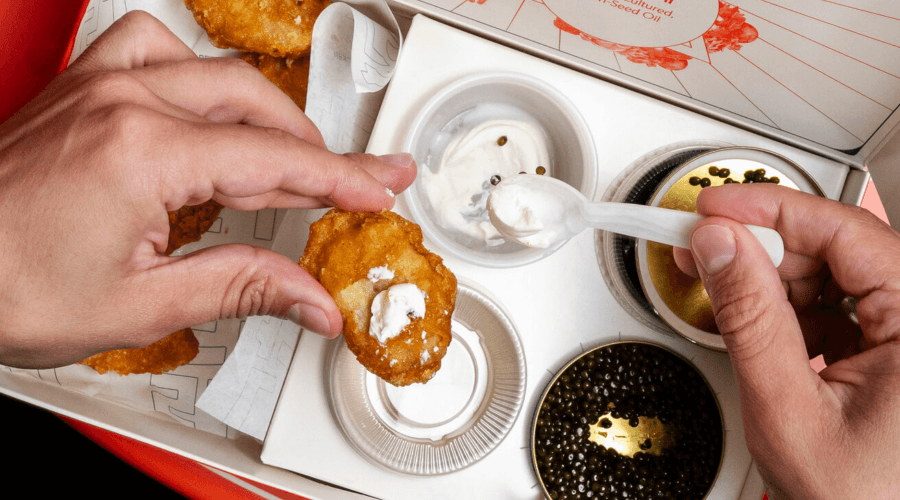As we move deeper into 2025, the way we order, receive, and enjoy food is transforming faster than ever. The food delivery trends 2025 show that convenience, technology, and sustainability are reshaping our dining habits. What was once a luxury—ordering takeout—is now an essential part of modern life. Thanks to advances in artificial intelligence, automation, and new customer expectations, online food delivery is no longer just about speed but also personalization and quality.
From drone deliveries to hyper-local kitchens and eco-friendly packaging, the future of food delivery looks smarter, greener, and more connected. Here’s a closer look at the key trends redefining the global dining experience in 2025.
1. AI-Powered Personalization: Tailoring Meals to Your Preferences
Artificial intelligence has completely changed how food delivery platforms operate. In 2025, AI-powered personalization helps apps predict exactly what users want before they even start browsing. Based on past orders, diet preferences, and even mood indicators, AI systems curate restaurant recommendations and custom meal options that feel handpicked.
Leading companies like Uber Eats and DoorDash are using machine learning algorithms to refine user suggestions. For example, if a customer orders sushi on Friday nights, the app might automatically highlight local sushi deals the following week. Similarly, health-focused apps such as HelloFresh offer AI-driven meal kits tailored to dietary goals and calorie preferences.
This kind of personalization makes food delivery more efficient and enjoyable. By offering precisely what customers crave, businesses boost retention rates while minimizing decision fatigue—a win-win for both sides.
Pro Tip: For startups or restaurants, integrating AI-driven analytics can significantly improve order accuracy and increase sales conversions.
2. Rise of Ghost Kitchens and Virtual Restaurants
Another major development in food delivery trends 2025 is the continued expansion of ghost kitchens—delivery-only restaurants that operate without traditional storefronts. These facilities allow multiple brands to share kitchen spaces, reducing costs while reaching a wider audience online.
According to Statista, the ghost kitchen industry is expected to exceed $170 billion by 2030. Platforms like CloudKitchens (backed by Uber founder Travis Kalanick) are helping restaurateurs launch new delivery brands with minimal investment. This model gives chefs flexibility to test new cuisines, menus, and branding strategies without traditional risks.
For customers, it means greater variety and faster service. You can order Italian, Thai, and vegan dishes from different brands—all prepared under one roof. The concept aligns perfectly with changing dining habits that prioritize convenience and innovation over dine-in experiences.
To learn more about innovative restaurant strategies, check out our internal post on AI Tools for Entrepreneurs, where technology and culinary creativity intersect.
3. Drone and Robot Deliveries Become Mainstream
Autonomous delivery isn’t just futuristic anymore—it’s here. In 2025, drones and ground robots are revolutionizing online food delivery by making it faster, cheaper, and more sustainable. Companies like Domino’s and Wing (Google’s Drone Service) have already deployed autonomous delivery systems in select cities, cutting delivery times in half.
These systems operate efficiently within short distances, avoiding traffic delays and reducing carbon emissions. Moreover, robotic delivery units from Starship Technologies are becoming popular in college campuses and residential neighborhoods, offering contactless delivery with 24/7 availability.
Beyond speed, automation also ensures reliability. AI-guided drones can calculate the most energy-efficient routes, while robots maintain precise temperature control—ensuring your pizza or sushi arrives just as it left the kitchen.
Pro Tip: Restaurants adopting drone or robot partnerships can cut logistics costs significantly while appealing to eco-conscious consumers.
4. Sustainable Packaging and Eco-Friendly Delivery
As environmental awareness grows, sustainability has become a top priority among food delivery trends 2025. Customers are demanding eco-friendly packaging, carbon-neutral shipping, and waste reduction from food brands.
Companies like Deliveroo and Grubhub are introducing compostable packaging and electric bike delivery fleets. Meanwhile, startups such as Loop are pioneering reusable packaging solutions, allowing containers to be collected, cleaned, and reused instead of discarded.
Consumers are more likely to choose brands that reflect their environmental values. According to a McKinsey report, 60% of global customers prefer food services with visible sustainability initiatives. Eco-conscious packaging not only reduces waste but also enhances brand reputation.
For practical tips on eco-friendly travel and lifestyle habits, explore our related guide: Sustainable Travel Guide.
5. Health-Conscious Dining and Functional Foods
The pandemic permanently shifted global dining habits, and health remains a major priority in 2025. Today’s consumers expect online food delivery services to offer nutritious, balanced, and functional meal options. From immunity-boosting smoothies to keto-friendly meal kits, the market for healthy, personalized food is booming.
Apps like Freshly and Green Chef are leading the trend by emphasizing calorie control, clean ingredients, and allergy-friendly menus. Even fast-food chains are joining in, introducing plant-based alternatives and low-carb offerings through delivery apps.
Moreover, wearable tech integration now allows users to sync fitness data with food delivery platforms. This creates customized meal recommendations aligned with health goals, whether you’re training for a marathon or managing your nutrition plan.
Pro Tip: In 2025, expect to see “food as medicine” concepts rise, combining nutrition and science to deliver holistic wellness through digital dining.
6. Hyperlocal Food Delivery and Farm-to-Table Revival
One of the most exciting food delivery trends 2025 is the return of local sourcing. Hyperlocal delivery focuses on connecting customers directly with nearby farms, artisans, and kitchens. This shortens supply chains, ensuring fresher produce and supporting small businesses.
Apps like Too Good To Go and Postmates are expanding their farm-to-door offerings, while niche platforms such as CrowdFarming allow users to “adopt” local producers and receive seasonal goods straight from the source.
This movement is reshaping dining habits by encouraging transparency and sustainability. Consumers want to know where their food comes from, and hyperlocal delivery ensures that freshness and ethical sourcing go hand in hand.
Additionally, it gives restaurants an edge—locally sourced ingredients often taste better and appeal to environmentally conscious diners.
7. Subscription Models and Meal Memberships
Subscription-based models are reshaping the online food delivery industry in 2025. Services like Blue Apron, EveryPlate, and Sunbasket allow customers to sign up for weekly or monthly meal kits, offering convenience and variety.
These memberships often include exclusive discounts, priority delivery, and personalized meal options. Consumers enjoy predictable spending and time savings, while restaurants benefit from recurring revenue and long-term customer loyalty.
In 2025, this model is evolving further with “multi-brand subscriptions.” Imagine paying one fee to access multiple restaurant menus across different cuisines. Companies like Relay are already exploring this shared ecosystem model, integrating subscription perks across platforms.
Pro Tip: For busy professionals and families, subscription dining offers both convenience and cost control—making it one of the fastest-growing food delivery trends.
8. The Future of Dining: Blurring Lines Between Delivery and Experience
While convenience remains key, the food delivery trends 2025 also focus on enhancing the overall dining experience. Virtual reality (VR) and augmented reality (AR) integrations are letting users “dine” in immersive environments from the comfort of home. Imagine enjoying a sushi meal while virtually seated on a Tokyo rooftop — that’s the future of experiential delivery.
Meanwhile, premium delivery platforms now offer live-stream cooking options. Customers can interact with chefs while their meal is being prepared, creating a connection similar to dining in an upscale restaurant. This experiential approach elevates online food delivery from transactional convenience to engaging entertainment.
As these innovations evolve, delivery will no longer be about just receiving food — it’ll be about savoring the moment, digitally and emotionally.
Final Thoughts: Redefining Dining Habits in a Digital Era
The year 2025 marks a defining moment for the food industry. Food delivery trends 2025 prove that technology, sustainability, and personalization are shaping not just how we order food, but how we live. Whether it’s drone-delivered meals, AI-curated menus, or hyperlocal sourcing, every innovation contributes to a smarter, more conscious way of eating.
For businesses, staying competitive means embracing these trends early. For consumers, it means enjoying unprecedented convenience and choice. One thing is certain: the future of online food delivery isn’t just about what’s on your plate—it’s about creating meaningful, digital-first dining experiences that fit seamlessly into modern life.
Hungry for more industry insights? Explore our internal guide on AI Tools for Small Business and learn how technology is shaping the business world beyond the dinner table.




